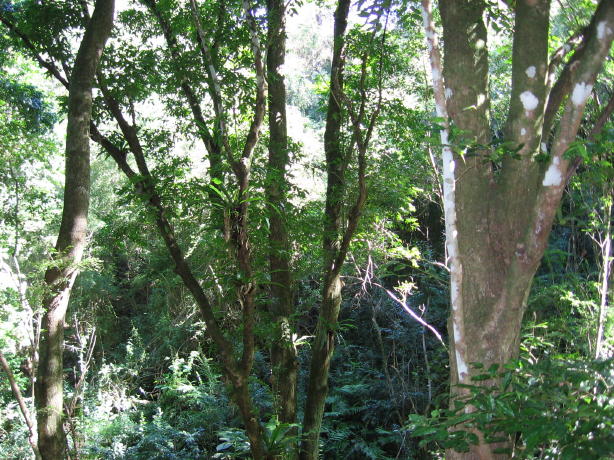About Sassafras and some opinions.
Sassafras is 50 Acres, or 20 Hectares.
Taken up from the Crown in 1889 – as 50 Acres, this was rather small
for the area at the time, it was one of a number of adjoning portions
taken up by the orginal owner, the others were much larger.
Europeans did not live in the valley until 1903 and then the first man
lived in a tree, they were big in those days.
There are photos in
the local museum that give some idea of the size of the trees.
There are still benches where trees were dragged out on some of our
hill sides, in some spots there are depressions and left over roots,
though these are more likely where stumps were burnt out or blown out
by lightning.
Sadly there are very few old growth trees on Sassafras, the few that
are tend to indicate that when measurements began maybe the biggest
were gone, or maybe they just hide.
Rainfall tends to be around 1500 mm a year, 2006 saw 1198 mm over the
year, when much of New South Wales, and Australia, was in drought.
Sassafras is a long thin block, about 170 metres wide, around 1.3 km
long. It fronts onto a large creek, Mooral Creek, at one end and
has a category
3 stream running along most of its’ length, we call it Stones Creek, it
also has a number of
ridges and gullies running across it that feed into Stones Creek.
Total catchment for the stream is about 283 hectares, close to 700
acres. It is quite a sight in full roar after 150 mm or
so of rain, only a few hours woth of rain when times are good.
One millimetre
a minute is common enough though drizzle all day long is more frequent
and then on occaission we'll get a couple of hundred millimetres in a
day. It is quite hilly here, it drains away quickly. If the
ground is dry it soaks in very quickly, empty a 10 litre bucket of
water on the ground as fast as you can, just dump it, and it soaks in,
it does not run away.
The soil is not sandy, it seems as though it is mostly decomposed
volcanic rock, Hornsfels and quite deep, a grey loam with with
the odd area of
red soils, possibly from old lava tubes. There are big worms,
about as fat your little finger, yes that
can be big. Roots follow their holes down into the soil, I saw
that when I was digging out a ledge for a 22,000 litre water
tank. We also have a little bit of Serpentine, that has a bit of
history, it is one of the by
products of mantle uplift at a subduction zone, our rock is left over
from that part of the mantle that got pushed up rather than down.
That makes hills or mountains. Apparently it mainly appears one
or two ranges away from the subduction zone, which we seem to be.
I have no doubt that the entire block has been cleared at various times
in the past century, with only a few trees left behind.
Photographic records indicate most of the valley floor was pasture in
the middle of last century. It doesn’t take long to clear warm
temperate rainforest with axes and fire or bull dozers and fire, heavy
frost will keep most of the species from surviving the first winter if
there is no protection, with fire finishing of any stragglers, then
there were the pigs, rabbits and cattle, roughly in that order.
When you clear even only moderately hilly land you you get erosion, I
suspect our internal creek has changed direction in a few places after
being choked with metre of silt washed down from the valleys above us and one dam collapse.
Toward the valley floor on open pasture temperatures of minus 8 degrees
Celsius
(and more) have been common on Winter mornings though Winters do seem to be getting a little milder. The
frost line extends well up the valley sides on those colder mornings, quite
visible on the pasture. Adiabatic cooling is very pronounced,
quite a rush of frigid air down the gullies in the early morning or
later in the afternoons in Winter. It doesn’t take much open
forest cover to give protection though and it does warm up fairly
swiftly even in Winter, usually to around 17 or 18 degrees or so.
Total named plant species is only around 200 so far, there are quite a
few I have yet to put names to, some of which I suspect will grow to be
middle or cover story trees. In the early years I would buy
plants from local Rainforest nurseries only to then discover the same
species elsewhere on the block. Interestingly a very high
percentage of these propagated from outside the valley did not
survive. I’ve noticed local collections (local provenances, more
on that elsewhere) survive and thrive better.
Regarding birds, so far my count is only around 40. I’m certain
there are more, for instance I haven’t identified the 2 or 3 (or more?)
different species of Owls that are around, I’ve just noted
“Owls”. I don’t usually carry binoculars so it’s rather hard to
ID little birds 20 or 30 metres up a tree, if you happen to hear them,
or see them.
For more information take a look through Projects where I'm putting
some of the stuff I've done on Sassafras, or learnt about it.
You'll also find other info in with the photos. Be a little
patient, this site only came into being Monday 27 March 2007, it will
take time to get what we have up here. We are learning how to use
the camera, so the photos will get better, might even do some movies or
sounds and the like.
One of the other things we may be doing is setting up a weather
station on the web, there is another in Taree perhaps 15 km away as the
crow
flies, you will see very significant differences.
If you would like to contact us please call Paul on 02 6550 5870 or
email paul@sassafras.id.au.


Paul Segal made this page using 

Unless otherwise noted, all content on this site was created by Paul Segal and is licensed under a Creative Commons Attribution-NonCommercial 3.0 Australia License.


Unless otherwise noted, all content on this site was created by Paul Segal and is licensed under a Creative Commons Attribution-NonCommercial 3.0 Australia License.